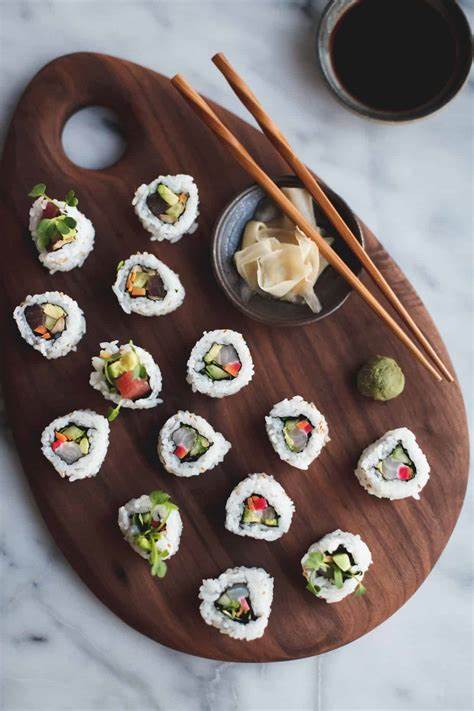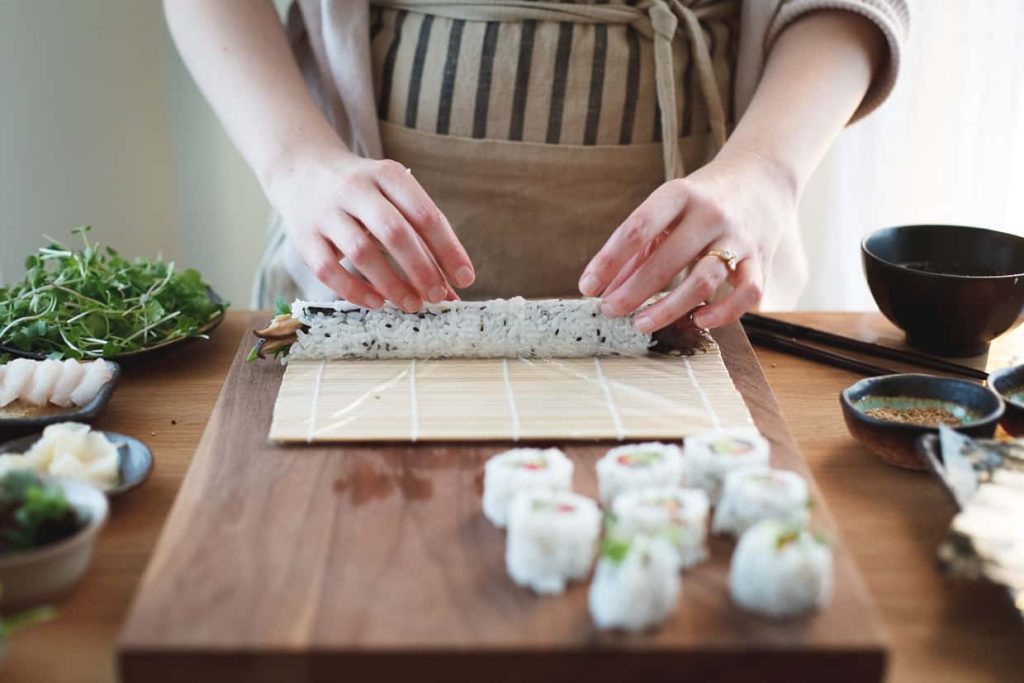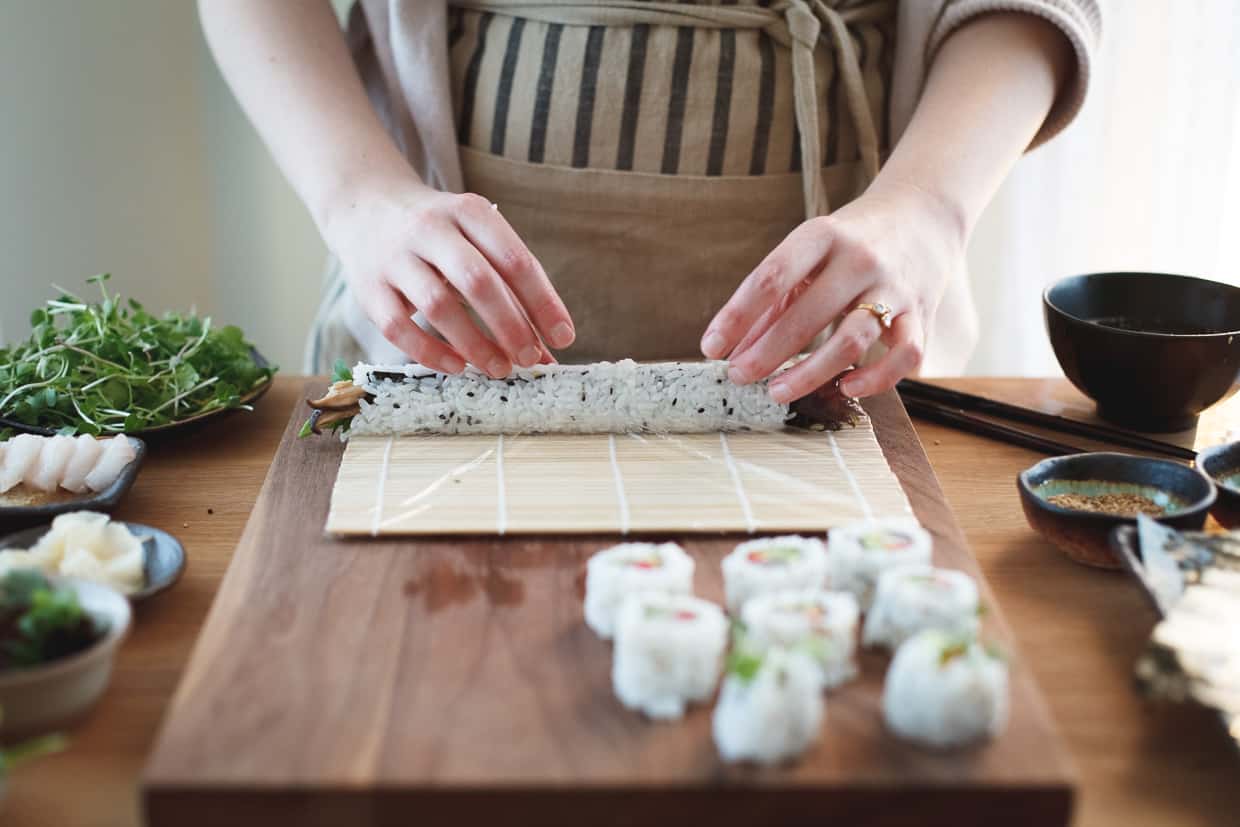Making professional-grade sushi at home can be a rewarding and enjoyable experience. It combines the precision of culinary art with the freshness of high-quality ingredients. Here’s a guide to help you master the basics of sushi-making and explore some creative variations.

Essential Ingredients and Tools
Basic Ingredients:
- Sushi rice (short-grain rice)
- Rice vinegar
- Sugar
- Salt
- Nori (seaweed sheets)
- Fresh fish (such as tuna, salmon, or yellowtail)
- Vegetables (like cucumber, avocado, and carrots)
- Soy sauce
- Wasabi
- Pickled ginger
Essential Tools:
- Bamboo sushi mat (makisu)
- Sharp knife (preferably a sushi or chef’s knife)
- Rice paddle (shamoji)
- Mixing bowl
- Plastic wrap
Steps to Making Perfect Sushi
- Prepare the Sushi Rice:
- Rinse 2 cups of sushi rice under cold water until the water runs clear.
- Cook the rice with 2 cups of water in a rice cooker or on the stovetop.
- While the rice is cooking, prepare the sushi vinegar by mixing 1/4 cup of rice vinegar, 2 tablespoons of sugar, and 1 teaspoon of salt until dissolved.
- Once the rice is cooked, transfer it to a large mixing bowl and gently fold in the sushi vinegar using the rice paddle. Be careful not to mash the rice. Let it cool to room temperature.
- Prepare the Ingredients:
- Slice the fresh fish into thin strips, about 1/4 inch thick.
- Cut the vegetables into thin, long strips.
- Prepare a bowl of water mixed with a little rice vinegar to dip your hands in while handling the rice to prevent sticking.
- Making Nigiri Sushi:
- Wet your hands with the vinegar water and take a small amount of rice (about the size of a small egg).
- Shape the rice into an oval ball using your fingers.
- Place a slice of fish over the rice and press gently to adhere.
- Making Maki Rolls (Sushi Rolls):
- Place a sheet of nori on the bamboo mat, shiny side down.
- Wet your hands and spread a thin layer of rice over the nori, leaving about 1 inch of the top edge uncovered.
- Place the fish and vegetable strips horizontally across the middle of the rice.
- Roll the bamboo mat away from you, pressing gently to shape the sushi into a firm roll. Use the uncovered edge of the nori to seal the roll.
- Slice the roll into bite-sized pieces with a sharp knife.
- Making Inside-Out Rolls (Uramaki):
- Cover the bamboo mat with plastic wrap to prevent sticking.
- Place a sheet of nori on the plastic wrap and spread a layer of rice over the nori.
- Sprinkle sesame seeds or tobiko (fish roe) over the rice for added texture and flavor.
- Flip the nori and rice over so the rice is on the outside.
- Place the fillings on the nori and roll as you would a regular maki roll.
- Serving and Presentation:
- Arrange the sushi pieces on a platter.
- Serve with soy sauce, wasabi, and pickled ginger on the side.
- Garnish with thinly sliced vegetables or edible flowers for a professional touch.
Tips for Professional-Grade Sushi
- Quality Ingredients:
- Use the freshest fish available. Sushi-grade fish is essential for both flavor and safety.
- Experiment with different types of fish and seafood, such as eel, shrimp, and scallops.
- Incorporate a variety of vegetables and garnishes to add color and texture.
- Precision and Practice:
- Take your time to practice the techniques of slicing fish and rolling sushi. Precision is key to achieving the clean, professional look of sushi.
- Use a very sharp knife to make clean cuts and avoid squashing the rice or fillings.
- Creativity and Variation:
- Experiment with different types of rolls, such as spicy tuna rolls, tempura rolls, or rainbow rolls.
- Try using alternative wraps like soy paper or cucumber strips instead of nori.
- Incorporate unique ingredients like mango, cream cheese, or sriracha mayo for creative fusion sushi.
- Presentation:
- Pay attention to the presentation of your sushi. Use colorful ingredients and arrange them thoughtfully on the plate.
- Use garnishes like sesame seeds, tobiko, or thinly sliced vegetables to add visual appeal.
Making sushi at home can be a fun and rewarding experience that allows you to enjoy the freshness and flavors of sushi without needing to visit a restaurant. With practice and creativity, you can create professional-grade sushi that will impress your family and friends. Enjoy the process and savor the delicious results!

